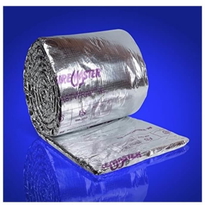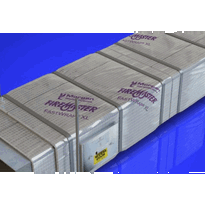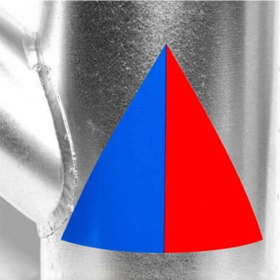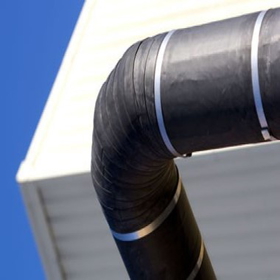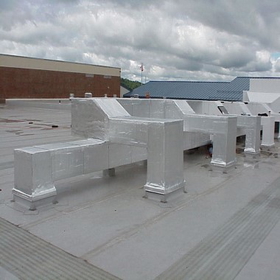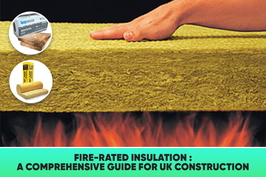Similar Categories
Understanding the Role of Fire Rated Duct Wraps in Building Safety
Fire rated duct wraps play an essential role in enhancing building safety by containing fires and slowing their spread. They create fire-resistant barriers around ductwork, preventing flames from travelling through HVAC systems. These wraps also block toxic smoke from breaking through, thanks to specialised inorganic materials, protecting occupants from inhalation hazards. Additionally, they reduce heat transfer across walls and roofs, helping to prevent the fire from spreading quickly. Insulation seals leaks, ensuring air reaches intended destinations. By compartmentalising fires to specific zones, they help keep other areas safe and reduce overall damage. Fire rated duct wraps also help maintain the structural integrity of ducts during extreme heat. This means escape routes, such as stairwells and corridors, remain safer for longer, offering more time for evacuation and improving overall building safety for everyone inside.
Materials and Manufacturing Processes of Fire-Rated Duct Wraps
Fire-rated duct wraps primarily utilise inorganic fibre materials, such as mineral wool and superwool, to provide heat resistance and fire protection. These materials are combined with manufacturing processes like lamination and encapsulation, which enhance strength and durability. These processes also improve the overall performance and longevity of the wraps, ensuring they meet or exceed international safety standards.
Inorganic Fiber Composition
Inorganic fibres form the core material of fire-rated duct wraps due to their exceptional heat resistance and non-combustible nature. These fibres, made from silica or alumina, provide excellent thermal insulation and durability. They are designed to withstand extremely high temperatures, often exceeding 2000°F (1093°C), while maintaining their shape during intense fires. The table below highlights some key characteristics:
| Material Type | Main Composition | Temperature Resistance |
|---|---|---|
| Silica-based | Silicon dioxide | Over 2000°F (1093°C) |
| Alumina-based | Aluminium oxide | Similar high endurance |
| Reinforcement | Scrim-reinforced foil | Improves durability |
These inorganic fibres are essential for ensuring safety, meeting stringent fire standards, and providing reliable protection in various building environments across the UK. Inorganic fibres are also favored because they do not emit toxic gases when exposed to high heat, enhancing safety during fire incidents.
Manufacturing and Encapsulation
Manufacturing and encapsulation processes play a vital role in ensuring that fire-rated duct wraps deliver their protective properties effectively. The production begins with needling, where fibres are mechanically interlaced to create a uniform and non-combustible mat. Needling enhances the structural integrity of the insulation, ensuring consistent performance during a fire. Foil lamination is then employed, applying scrim-reinforced foil through adhesive or thermal bonding to provide strength and moisture resistance. During encapsulation, inorganic insulation is sealed within foil layers, preventing fibre release and enhancing durability. Pre-cut sizing guarantees standard overlap dimensions for proper installation. Structural reinforcement methods, such as adding scrim fabric between foil layers, increase tear resistance. These processes collectively produce a reliable, fire-resistant wrap that offers insulation, containment, and structural integrity during a fire.
How Fire Ratings Are Determined and Standards Met
Determining fire ratings for ducts involves a series of standardised tests and certifications to guarantee safety and performance during fires.
These tests evaluate the duct's ability to contain fire, prevent flame spread, and maintain structural integrity. For grease ducts, ASTM E2336 is the primary standard, requiring compliance with strict criteria for two-layer systems and passing specific fire containment tests.
Air ducts are tested under ISO 6944, which assesses their resistance to fire and stability during high temperatures. Certifications from trusted third-party agencies such as UL and Intertek verify adherence to these standards.
The process includes documenting test results and confirming that all products meet local building regulations. Overall, these procedures help ensure that fire-rated duct wraps perform reliably, protecting people and property during emergencies.
Key Product Options and Specifications Available
Several product options and specifications are available to meet different fire safety requirements in the UK. These products often utilise inorganic fibre blankets, like those in 3M Fire Barrier Duct Wrap 615+, which are encapsulated with scrim-reinforced foil for enhanced fire resistance. Some wraps are made from calcium-magnesium-silicate (CMS), known for its high-temperature and bio-soluble properties. Thickness varies, typically around 1.5 inches, with various options for higher fire ratings. The density is generally around 6 pcf, and the weight is approximately 0.9 psf. Many wraps provide fire ratings of 1 or 2 hours and comply with standards such as ASTM E 2336, UL, and IBC. These wraps also offer excellent thermal performance, with high service temperature capabilities and benefits such as a lightweight design and easy installation. In addition, these insulation materials are designed to be asbestos-free and maintain effective barriers against flame, smoke, and gases, ensuring comprehensive fire safety.
Proper Installation and Maintenance Practices
Proper installation and ongoing maintenance are crucial for ensuring that fire-rated duct wraps function as intended in safeguarding building safety.
Correct installation involves meticulously following the manufacturer's instructions, employing approved fixing methods such as pins or steel straps, and ensuring overlaps are a minimum of 100 mm, secured with tape.
During installation, it's essential to observe safety precautions, including wearing personal protective equipment (PPE) and maintaining adequate ventilation.
Regular inspections are necessary to identify any damage or wear, with any compromised sections needing prompt replacement.
Proper training for maintenance staff is vital, along with employing approved cleaning methods.
Compliance with local regulations and standards must always be verified, including necessary testing and certifications.
Addressing common issues such as sagging or moisture damage is important to uphold the duct wrap’s fire resistance and overall safety performance.
Applications Across Different Building Types and Spaces
Fire-rated duct wraps are utilised in various building types across the UK to enhance safety and comply with fire protection regulations.
In residential properties, they safeguard dryer vents and multi-unit dwellings, preventing the spread of fires.
Commercial establishments employ them on air ducts and kitchen grease ducts to manage high temperatures and avert fire hazards.
Industrial facilities depend on these wraps for hazardous chemical exhaust systems, ensuring safety in challenging environments.
Institutional buildings such as hospitals and schools benefit from duct wraps that contribute to maintaining secure spaces.
High-rise flats rely on these wraps for fire safety across multiple compartments.
Specific areas like commercial kitchens, laundry rooms, utility rooms, HVAC zones, and rooftops are protected by duct wraps, which help to prevent heat transfer and the spread of fire.
Ensuring Compliance With Safety Regulations and Standards
Ensuring compliance with safety regulations and standards is essential for the effective use of fire-rated duct wraps. It helps protect people and property by meeting legal and industry requirements within the UK. To achieve this, manufacturers and installers should focus on key certifications and codes:
- ASTM E2336 Certification for grease duct systems; requires fire resistance testing and two-layer installation.
- ISO 6944 Compliance for air ducts; guarantees fire resistance under standardised conditions.
- UL/Intertek Listings verify products through independent testing and certification.
- Regional Building Codes such as the Building Regulations and British Standards set specific requirements for installation, thickness, and documentation.
- Staying updated on local building authority approvals is crucial, especially as applications evolve with increasing performance-based requirements for fire rated duct products. Meeting these standards fosters trust among industry professionals and ensures that everyone feels part of a safety-conscious community dedicated to quality.
Conclusion
Fire-rated duct wraps play a vital role in building safety by providing insulation and fire protection for ductwork. They are made from specialised materials designed to withstand high temperatures and meet strict safety standards. Proper installation and regular maintenance ensure they perform effectively. These wraps are essential in various building types, helping to confirm compliance with safety regulations. Overall, selecting the right fire-rated duct wrap enhances safety without complicating building design.
